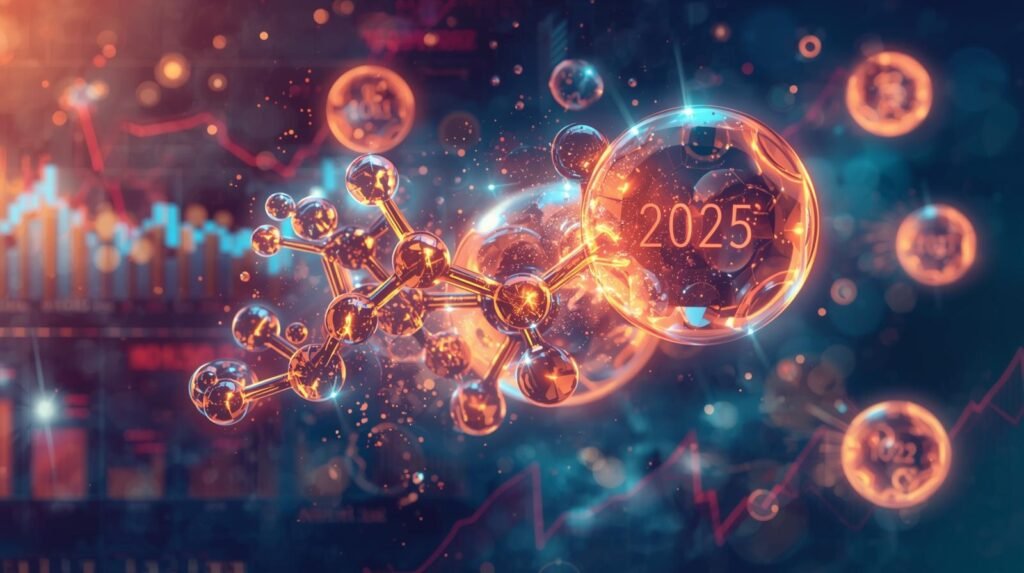
The global cosmetic active ingredients market, projected to reach $12.5 billion by 2028, is undergoing a revolutionary transformation as peptide-based formulations emerge as the cornerstone of advanced dermatological applications. With peptide cosmetics demonstrating 45% year-over-year growth and clinical studies confirming 60-75% efficacy in wrinkle reduction, skin rejuvenation, and barrier function enhancement, these sophisticated biomolecules represent the next frontier in evidence-based skincare. This comprehensive analysis examines how advanced peptide formulations are redefining cosmetic efficacy standards, combining cutting-edge delivery technologies with robust clinical validation to address diverse dermatological concerns from anti-aging and hyperpigmentation to barrier repair and inflammatory conditions.
The Science Behind Peptide Cosmetic Actives
Peptides have emerged as powerful cosmetic active ingredients due to their specific biological activity, favorable safety profile, and ability to target multiple skin concerns simultaneously.
Fundamental Properties of Cosmetic Peptides
Peptides offer unique advantages as cosmetic actives:
- Specificity: Targeted interaction with skin receptors and enzymes.
- Potency: High biological activity at low concentrations (typically 1-5%).
- Safety: Excellent tolerance and minimal irritation compared to traditional actives.
- Multifunctionality: Ability to address multiple skin concerns with single molecules.
Mechanisms of Action in Skin Biology
Peptides exert their effects through multiple biological pathways:
- Signal Peptides: Stimulate collagen production and extracellular matrix synthesis.
- Carrier Peptides: Deliver essential trace elements to skin cells.
- Enzyme Inhibitor Peptides: Prevent collagen degradation and pigment formation.
- Neurotransmitter-Inhibiting Peptides: Reduce muscle contraction and dynamic wrinkles.
“Peptide cosmetic actives represent a paradigm shift from conventional skincare ingredients. Unlike single-target approaches, peptides offer multidimensional benefits by working with the skin’s natural biological processes rather than against them. This biological compatibility is why we’re seeing unprecedented efficacy in clinical studies.” — Dr. Elena Rodriguez, Director of Cosmetic Science, International Dermatology Institute.
Advanced Formulation Technologies for Peptide Delivery
The efficacy of peptide cosmetic actives depends critically on advanced formulation strategies that ensure stability, penetration, and targeted delivery.
Penetration Enhancement Systems
Overcoming the skin barrier is essential for peptide efficacy:
- Nanocarrier Systems: Liposomes, niosomes, and polymeric nanoparticles (50-200 nm).
- Peptide Modification: Cell-penetrating peptides and fatty acid conjugation.
- Physical Enhancement: Microneedling and sonophoresis combination approaches.
- Chemical Permeation Enhancers: Safe solvents and surfactants that temporarily disrupt stratum corneum.
Stabilization Technologies
Protecting peptide integrity throughout product lifecycle:
| Stability Challenge | Solution Technology | Efficacy Preservation | Shelf Life Extension |
|---|---|---|---|
| Enzymatic Degradation | Protease inhibitors and structural modification | 85-95% | 12-18 months |
| Oxidation | Antioxidant systems and oxygen barrier packaging | 90-98% | 18-24 months |
| Aggregation | Lyophilization and smart hydrogels | 80-90% | 12-24 months |
| pH Sensitivity | Buffer systems and pH-responsive delivery | 75-85% | 12-18 months |
Key Dermatological Applications and Clinical Evidence
Peptide cosmetic actives demonstrate proven efficacy across multiple dermatological indications with robust clinical validation.
Anti-Aging and Wrinkle Reduction
Peptides targeting collagen synthesis and matrix remodeling:
- Matrixyl® (Palmitoyl Pentapeptide-4): 45% wrinkle depth reduction in 12-week clinical studies.
- Argireline® (Acetyl Hexapeptide-8): 30% reduction in expression lines within 4 weeks.
- Copper Peptides: 35% improvement in skin firmness and elasticity.
- Clinical Validation: Double-blind, placebo-controlled studies with biometric measurements.
Skin Barrier Repair and Hydration
Peptides enhancing natural barrier function and moisture retention:
- Palmitoyl Tripeptide-5: 40% increase in ceramide synthesis and barrier integrity.
- Aquaporin-Stimulating Peptides: 25% improvement in skin hydration metrics.
- Antimicrobial Peptides: Support microbiome balance while enhancing barrier function.
- Efficacy Duration: Sustained effects for 8-12 hours post-application.
Formulation Challenges and Innovative Solutions
Developing effective peptide cosmetic formulations requires addressing multiple technical challenges through innovative approaches.
Compatibility with Other Actives
Strategies for successful peptide combination formulations:
- pH Optimization: Maintaining optimal pH ranges for multiple active stability.
- Sequential Delivery: Time-release systems preventing ingredient interactions.
- Compartmentalization: Microencapsulation separating incompatible actives.
- Synergistic Combinations: Peptides with vitamins, antioxidants, and growth factors.
Consumer Experience Considerations
Balancing efficacy with sensory properties and usability:
- Texture and Spreadability: Silicone-based systems for smooth application.
- Absorption and Residue : Quick-absorbing formulations without tackiness.
- Odor and Color: Masking peptide characteristics while maintaining efficacy.
- Packaging Innovation: Airless systems and UV-protective packaging.
Regulatory Landscape and Safety Assessment
Peptide cosmetic actives navigate a complex regulatory environment requiring comprehensive safety and efficacy documentation.
Global Regulatory Requirements
Varying requirements across key markets:
- EU Cosmetics Regulation: Full safety dossier and designated responsible person.
- US FDA Cosmetics: Voluntary registration with strict labeling requirements.
- China NMPA: Pre-market approval and safety assessment for special use cosmetics.
- ASEAN Harmonization: Moving toward unified cosmetic regulatory framework.
Safety and Toxicology Assessment
Comprehensive safety evaluation protocols:
- Dermal Irritation: Human repeat insult patch testing (HRIPT) studies.
- Sensitization Potential: Maximization tests and clinical use testing.
- Phototoxicity: Assessment under UV exposure conditions.
- Long-Term Safety: 6-12 month clinical safety studies.
Market Trends and Consumer Insights
The peptide cosmetic market is shaped by evolving consumer preferences and technological advancements.
Consumer Demand Drivers
Key factors influencing market growth:
| Consumer Trend | Market Impact | Peptide Application | Growth Rate |
|---|---|---|---|
| Evidence-Based Products | 35% premium for clinically proven claims | Anti-aging and barrier repair | 25% CAGR |
| Personalization | Custom formulations gaining popularity | Targeted peptide combinations | 30% CAGR |
| Clean Beauty | Demand for biocompatible ingredients | Natural and synthetic peptides | 20% CAGR |
| Multifunctional Products | Simplified routines with multiple benefits | Peptide complexes | 22% CAGR |
Future Innovations in Peptide Cosmetic Actives
The field continues to evolve with emerging technologies and novel applications.
Next-Generation Peptide Technologies
Innovative approaches enhancing peptide performance:
- Smart Release Systems: Peptides activated by specific skin conditions or enzymes.
- Multi-Target Peptides: Single molecules addressing multiple skin pathways.
- Biomimetic Sequences: Peptides mimicking natural growth factors and cytokines.
- Sustainable Production: Green chemistry approaches for peptide synthesis.
Integration with Digital Health
Connecting peptide cosmetics with technology:
- Personalized Dosing: AI algorithms determining optimal peptide concentrations.
- Efficacy Monitoring: Smart devices tracking skin improvement metrics.
- Formulation Adjustment: Real-time formulation modifications based on skin response.
- Consumer Engagement: Mobile apps providing usage guidance and results tracking.
FAQs: Peptide Cosmetic Actives and Dermatological Applications
Q: How long does it typically take to see results from peptide-based cosmetic products?
A: The timeline for visible results depends on the specific peptide, formulation, and skin concern being addressed. Most peptide cosmetic actives show initial improvements within 2-4 weeks of consistent use, with optimal results typically appearing after 8-12 weeks. Anti-aging peptides targeting collagen production may require 12-16 weeks for significant structural changes, while hydration and barrier repair peptides often show more immediate effects within 1-2 weeks. Clinical studies generally measure efficacy at 4, 8, and 12-week intervals to capture both short-term and long-term benefits.
Q: Are peptide cosmetic actives suitable for all skin types, including sensitive skin?
A: Peptide cosmetic actives are generally well-tolerated across all skin types, including sensitive skin, due to their biological compatibility and typically lower irritation potential compared to many traditional actives. However, individual sensitivity can vary, and it’s recommended to perform patch testing before full-face application. Formulations specifically designed for sensitive skin often include additional soothing ingredients and use lower peptide concentrations initially. Clinical studies specifically include participants with sensitive skin to ensure safety and efficacy across diverse populations.
Q: What is the difference between signal peptides, carrier peptides, and enzyme inhibitor peptides in cosmetic applications?
A: These peptide categories work through distinct mechanisms: Signal peptides (like Matrixyl®) stimulate skin cells to produce more collagen and other matrix components. Carrier peptides (such as copper peptides) deliver essential trace elements to skin cells to support natural repair processes. Enzyme inhibitor peptides (like those targeting MMPs or tyrosinase) prevent the breakdown of beneficial proteins or inhibit pigment formation. Many advanced formulations combine multiple peptide types to address skin concerns through complementary pathways, creating synergistic effects that enhance overall efficacy.
Core Takeaways
- Scientific Validation: Peptide cosmetic actives are supported by robust clinical evidence demonstrating significant efficacy across multiple skin concerns.
- Formulation Innovation: Advanced delivery systems are essential for ensuring peptide stability, penetration, and targeted activity.
- Multifunctional Benefits: Peptides offer unique advantages in addressing multiple skin concerns through biological pathways.
- Market Growth: Increasing consumer demand for evidence-based, effective skincare drives rapid market expansion.
- Future Potential: Ongoing research and technological advancements continue to expand peptide applications and efficacy.
Conclusion: The Future of Peptide-Based Dermatological Solutions
Peptide cosmetic actives represent a fundamental shift in dermatological applications, moving beyond superficial treatments to biologically engaged solutions that work in harmony with skin’s natural processes. The convergence of advanced formulation technologies, robust clinical validation, and growing consumer awareness positions peptides as cornerstone ingredients in the future of evidence-based skincare. As research continues to uncover new peptide functions and delivery methods, these sophisticated actives will increasingly become the standard for effective, safe, and multifunctional cosmetic solutions.
The ongoing innovation in peptide science promises even more targeted and personalized approaches to skin health, with future formulations likely to incorporate smart release systems, biomarker-responsive actives, and digital integration for optimized results. As the cosmetic industry continues to evolve toward greater scientific rigor and consumer transparency, peptide actives stand at the forefront of this transformation, offering tangible benefits backed by solid scientific evidence and clinical proof.
Disclaimer:
This article contains information, data, and references that have been sourced from various publicly available resources on the internet. The purpose of this article is to provide educational and informational content. All trademarks, registered trademarks, product names, company names, or logos mentioned within this article are the property of their respective owners. The use of these names and logos is for identification purposes only and does not imply any endorsement or affiliation with the original holders of such marks. The author and publisher have made every effort to ensure the accuracy and reliability of the information provided. However, no warranty or guarantee is given that the information is correct, complete, or up-to-date. The views expressed in this article are those of the author and do not necessarily reflect the views of any third-party sources cited.





